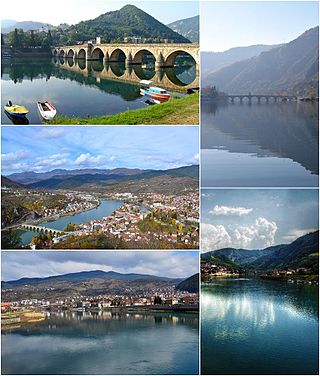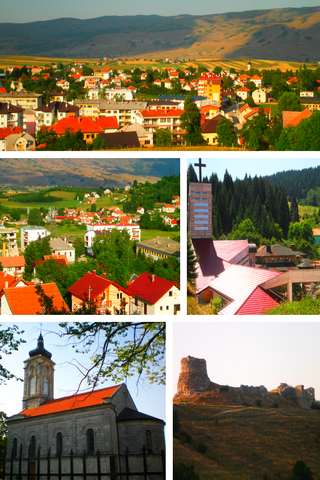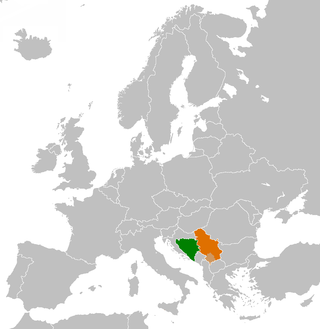
Trebinje is a city and municipality in Republika Srpska entity, Bosnia and Herzegovina. It is the southernmost city in Bosnia and Herzegovina and is situated on the banks of the Trebišnjica river in the region of East Herzegovina. As of 2013, it has a population of 31,433 inhabitants. The city's old town quarter dates to the 18th-century Ottoman period, and includes the Arslanagić Bridge, also known as Perovića Bridge.

Zvornik is a city in Republika Srpska, Bosnia and Herzegovina. In 2013, it had a population of 58,856 inhabitants. Zvornik is located on the Drina River, on the eastern slopes of Majevica mountain, at the altitude of 146m.

Gradiška is a city in Bosnia and Herzegovina. As of 2013, it has a population of 51,727 inhabitants, while the city of Gradiška has a population of 14,368 inhabitants.

Sanski Most is a town and municipality located in the Una-Sana Canton of the Federation of Bosnia and Herzegovina, an entity of Bosnia and Herzegovina. It is situated on the banks of the Sana River in northwestern Bosnia and Herzegovina, in the region of Bosanska Krajina, between Prijedor and Ključ. As of 2013, it has a population of 41,475 inhabitants.

Kotor Varoš is a town and municipality in Republika Srpska, Bosnia and Herzegovina. As of 2013 census, the municipality has a population of 19,710 inhabitants, while the town of Kotor Varoš has a population of 7,330 inhabitants.

Višegrad is a town and municipality in Republika Srpska, Bosnia and Herzegovina. It rests at the confluence of the Drina and the Rzav river. As of 2013, the municipality has a population of 10,668 inhabitants, while the town of Višegrad has a population of 5,869 inhabitants.

Podrinje is the Slavic name of the Drina river basin, known in English as the Drina Valley. The Drina basin is shared between Bosnia and Herzegovina and Serbia, with majority of its territory being located in Eastern Bosnia, entire Upper Drina course and majority of the Middle course, while the Lower Drina course is shared between two countries,with the river representing border. The part of the Drina basin located in Bosnia and Herzegovina is also called Eastern Bosnia.

Rafael "Ranko" Boban was a Croatian military commander who served in the Ustaše Militia and Croatian Armed Forces during World War II. Having participated in the Velebit uprising in 1932, he joined the Royal Italian Army and returned to Croatia following the Axis invasion of Yugoslavia in April 1941. He fought with the Ustaše until the end of the war, when he is reported to have evaded the Yugoslav Partisans and reached the Austrian town of Bleiburg. Nothing is known of what happened to him afterwards, and it was rumoured that he was either killed in Podravina in 1945, died fighting with the Crusaders in Herzegovina in 1947, or, less likely, emigrated to the United States via Argentina, joined the United States Army and fought Communist forces in the Korean War. In 1951, he was named the Croatian Minister of Defence in-exile by Ustaše leader Ante Pavelić.

Glamoč is a town and the seat of the Municipality of Glamoč in Herzeg-Bosnia Canton of the Federation of Bosnia and Herzegovina, an entity of Bosnia and Herzegovina. It is situated in southwestern Bosnia and Herzegovina, at the foothills of Staretina and Velika Golija mountains, and on the edge of the central part of the Glamočko Polje.

The modern-day countries of Bosnia and Herzegovina and Serbia both originated from Yugoslavia. The majority of population in both countries speak one of the standard varieties of Serbo-Croatian and Serbia is one of the largest investors in Bosnia and Herzegovina.

Herzegovina is the southern and smaller of two main geographical regions of Bosnia and Herzegovina, the other being Bosnia. It presently does not have strictly defined administrative borders, however in the past it was organized as Sanjak of Herzegovina and Herzegovina Eyalet (1833–1851).
Ključ is a village in the municipality of Gacko, Republika Srpska, Bosnia and Herzegovina.
Tešan Podrugović was Serbian merchant, hayduk, storyteller and gusle player who participated in the First Serbian Uprising and Second Serbian Uprising. He was one of the most important sources for Serbian epic poetry recorded by Vuk Karadžić. Podrugović did not sing but used to 'speak' his poems; he understood and felt the poems and thought about what he said. He was Serbia's best known fiddle player (guslar) after Filip Višnjić.
The Schutzkorps was an auxiliary volunteer militia established by Austro-Hungarian authorities in the newly annexed province of Bosnia and Herzegovina to track down Bosnian Serb opposition, while its main victims were civilians. Officially, they were an auxiliary gendarmerie, while in reality, they conducted illegal and repressive activities. It predominantly drew recruits from members of the Bosniak population and it became infamous as a result of its heavy involvement in the persecution of the Serbs. They particularly targeted Serb populated areas of eastern Bosnia.
The May 1941 Sanski Most revolt occurred near the town of Sanski Most in what was at the time Axis-occupied Yugoslavia. The Serb population revolted against oppression by the Ustaše regime, the rulers of the Independent State of Croatia who were sponsored by Nazi Germany. Many civilians died during the three days of hostilities.
Grdan was the vojvoda (duke) of the Nikšić nahija, part of the Sanjak of Herzegovina, who led several uprisings against the Ottomans in between 1596 and 1612, alongside Serbian Patriarch Jovan Kantul.

The Serb uprising of 1596–1597, also known as the Herzegovina uprising of 1596–1597, was a rebellion organized by Serbian Patriarch Jovan Kantul and led by Grdan, the vojvoda ("duke") of Nikšić against the Ottomans in the Sanjak of Herzegovina and Montenegro Vilayet, during the Long Turkish War (1593–1606). The uprising broke out in the aftermath of the failed Banat Uprising in 1594 and the burning of Saint Sava's relics on 27 April 1595; it included the tribes of Bjelopavlići, Drobnjaci, Nikšić, and Piva. The rebels, defeated at the field of Gacko in 1597, were forced to capitulate due to a lack of foreign support.

The Kulen Vakuf massacre was committed during World War II by Communist-led Yugoslav Partisans and groups of non-communist Serb rebels, killing 1,000 to 3,000 Ustaše prisoners as well as Muslim, and a smaller number of Croat, civilians in early September 1941 in Kulen Vakuf, part of the Independent State of Croatia. The local Ustaše had previously massacred Serbs in Kulen Vakuf and surrounding villages.
Radojica Perišić was a Serbian priest and Chetnik leader and one of the main leaders of the June 1941 uprising in eastern Herzegovina during the World War II. Perišić was born in Kazanci 1906. During the World War II he was commander of the Chetnik Gacko Brigade. Perišić was killed by Ustaše in April 1945. The post-war communist historiography intentionally ignored the June 1941 uprising in eastern Herzegovina because it would contradict the communist narrative about rebels being led by communists. In the period after the Fall of the Berlin Wall Gacko municipality proclaimed 6 June as their holiday in honor of the beginning of the uprising and held public ceremonies on 6 June as the Day of Gacko.

The Drvar uprising was the World War II uprising of the Serb population of Bosnian Krajina. Italy supported it, both politically and in arms, in its struggle against the fascist puppet state of the Independent State of Croatia between 27 July and 26 September 1941.


























